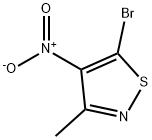
5-BroMo-3-Methyl-4-nitroisothiazole synthesis
- Product Name:5-BroMo-3-Methyl-4-nitroisothiazole
- CAS Number:35610-98-1
- Molecular formula:C4H3BrN2O2S
- Molecular Weight:223.05

20493-60-1
82 suppliers
$79.75/250mg

35610-98-1
11 suppliers
inquiry
Yield:-
Reaction Conditions:
with fuming sulfuric acid;nitric acid
Steps:
2.5. Synthesis of 3-methyl-4-nitroisothiazole (1)
General procedure: 3-Methyl-4-nitroisothiazole (1), used in experiments, was obtainedas a result of easily feasible and efficient decarboxylationprocess of 3-methyl-4-nitro-5-isothiazolecarboxylic acid (9) duringits dry pyrolysis at 120e130 C (Fig. 3). A starting material of totalsynthesis was known 5-amino-3-methyl-4-isothiazolecarboxylicacid (2) [23] or its N-benzoyl derivatives [8] which were transformedinto known 5-amino-3-methylisothiazole (3) [1] in efficientway by decarboxylation with hot concentrated sulphuric acid. Inthe case of N-benzoyl derivatives [8] deacylation and decarboxylationprocesses occur simultaneously during this reaction. Then,amine 3, in Sandmayer reaction type, gave known 5-bromo-3-methylisothiazole (4) [1] which was undergone nitration processresulting in known 5-bromo-3-methyl-4-nitroisothiazole (5) [1]. Itis worthy to note, that the use of 20% oleum instead of concentrationsulphuric acid in nitrating mixture gives better results. In turn,the compound 5 was transformed into known 3-methyl-4-nitro-5-isothiazolecarbonitrile (6) [24] in reaction with cuprous cyanide(CuCN) in heptane. It appeared that, apart the main product 6, sideproducts,namely, previously described 3-methyl-4-nitro-5-isothiazolecarboxamide (7) [24] and unknown up to date - 3,30-dimethyl-4,40-dinitro-5,50-bisisothiazole (8) have been also separatedfrom final reaction mixture during purification process. Creationof 3,30-dimethyl-4,40-dinitro-5,50-bisisothiazole (8) can point out that the reaction has radical nature. However, Small amounts of3-methyl-4-nitro-5-isothiazolecarboxamide (7) can probably ariseduring purification on silica-gel through hydrolysis of 3-methyl-4-nitro-5-isothiazolecarbonitrile 6. Then, nitrile 6 has been hydrolysedinto 3-methyl-4-nitro-5-isothiazolecarboxylic acid (9) [24]with 95% H2SO4 in the presence of sodium nitrite. Acid 9 can be alsosuccessfully obtained through denitrogenation of 3-methyl-4-nitro-5-isothiazolecarboxamide (7) under influence of nitrousacid generated in situ from nitrites, where nitrite agent fulfillscrucial role.
References:
Regiec, Andrzej;Wojciechowski, Piotr [Journal of Molecular Structure,2019,vol. 1196,p. 370 - 388]

40184-32-5
4 suppliers
inquiry

35610-98-1
11 suppliers
inquiry